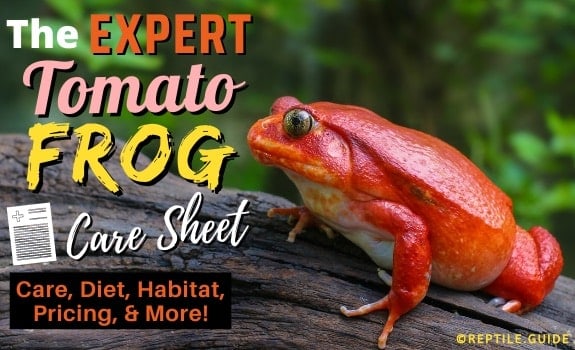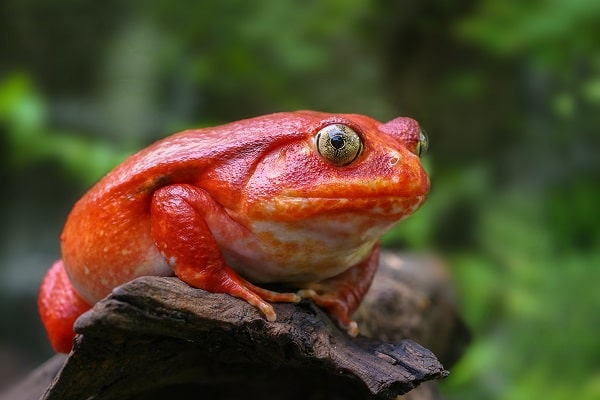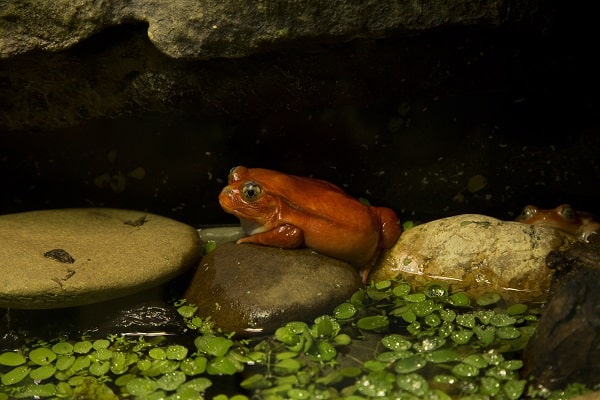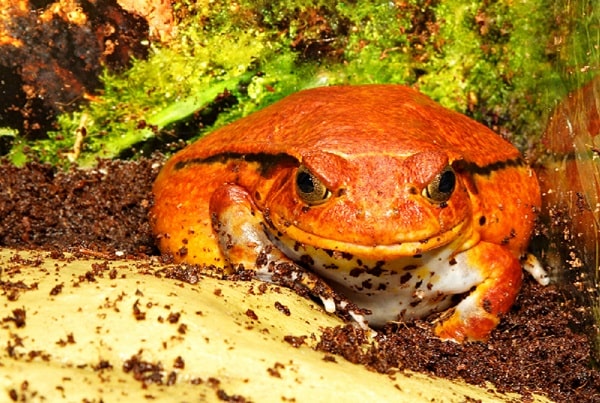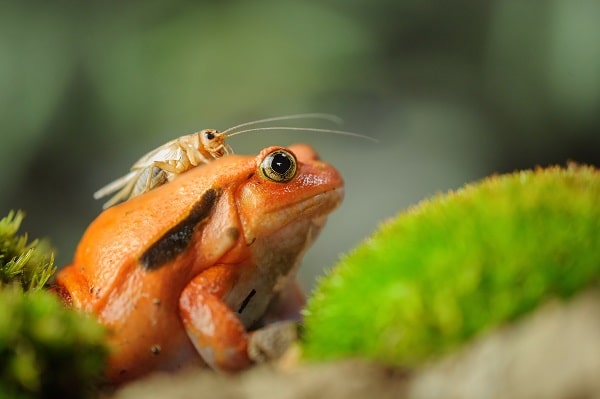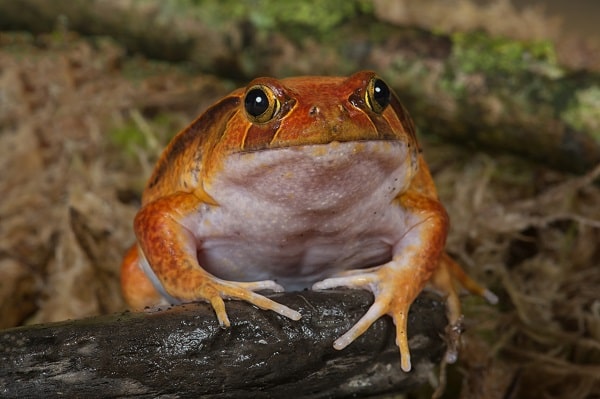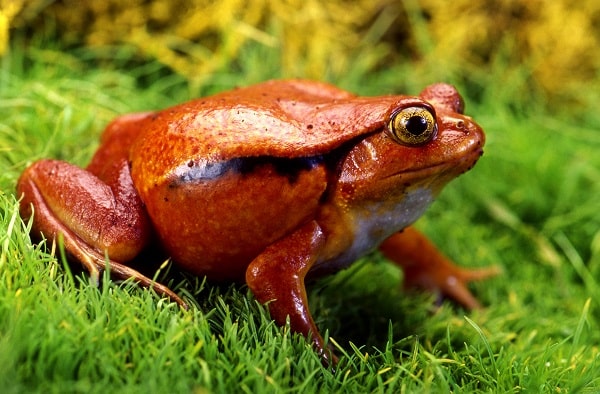Tomato Frogs are relatively popular as pets thanks to their bright coloration, confident demeanor, cute faces, small space requirements, and simple husbandry.
ALL a Tomato Frog needs to be healthy is a 10-gallon aquarium with water and damp substrate for burrowing. The bells and whistles of heating, lighting, and decorations galore aren’t necessary – but they are appreciated!
Still not sure if the Tomato Frog is the right pet for you? Let’s find out more!
| Facts at a Glance: | |
|---|---|
| Common name | Tomato Frog |
| Scientific name | Dyscophus antongilii, insularis, and guineti. |
| Adult size | 4.5 Inches |
| Price | $25 to $30 |
| Lifespan | 6-8 years |
| Diet | Insectivores |
| Tank Size | Minimum 10 gallon per each frog housed |
| Temperature & Humidity | 65-80 Degrees Fahrenheit with Humidity 65-80% |
| Popular alternatives | Pacman Frog, Pixie Frog |
In This Article
Tomato Frog Species Summary
Tomato Frog is the name (opens in new tab) used to refer to three separate species of frog in the Dyscophus genus: Dyscophus antongilii, Dyscophus insularis, and Dyscophus guineti.
All of these species are native to the island of Madagascar, which is off the coast of Africa.
Dyscophus frogs are part of the largest family of frogs on earth, Microhylidae, also known as small-mouthed frogs. Dyscophus guineti is the species that are typically found in pet stores, reptile shows, and pet sales websites.
Tomato Frogs are named after their reddish-orange coloration and their defense mechanism. When threatened, a Tomato Frog will inflate its body, turning itself into a small red round “tomato”!
The inflated shape makes it difficult for predators to swallow this Tomato (Frog), but they also have another trick up their sleeve…
When threatened, Tomato Frogs secrete a thick, white, glue-like mucus. This mucus causes numbness, which usually triggers the predator to release the lucky frog.
Tomato Frogs spend their lives in boggy, sub-tropical forests, swamps, and marshes.
According to the Smithsonian, it is here that they spend their days burrowed under moist dirt and leaves while opportunistically nabbing whatever worm or grub they encounter underground.
Surprisingly, even though they’re amphibians, they can’t swim very well and sometimes even drown! Being nocturnal, Tomato Frogs move around and hunt at night.
While Tomato Frogs lay eggs almost every month of the year, they are mostly reproductive in the rainy season, January through May.
Males make a guttural trill to attract female mates. While in shallow water, they lock in a position that researchers refer to as “amplexus”, where the male can fertilize the female’s 1,000 to 1,500 eggs as she lays them.
Eggs take around 36 hours to hatch, and the filter-feeding tadpoles metamorphosize after about 45 days.
⭐️ Fun Fact: Oddly enough the Dyscophus guineti is the ONE species that some scientists refer to as the “False Tomato Frog,” even though it’s biology and appearance are nearly identical to the other Tomato Frog species! It’s also known as the Sambava Tomato Frog, and Malagasy people call it by its mating trill sound, “Sangongon.
Appearance & Colors
Newly-morphed Tomato Frog froglets are drab light brown with a black band that extends from their eye and separates their cream-colored belly.
As the frog matures, it develops its namesake reddish or orangish coloration. Female Tomato Frogs are known for being bright shades of orange or red, while males tend to become dull reddish-brown or yellow-orange.
They typically retain the dark brown eye band and off-white belly and sometimes develop black spots on their throats.
Their bodies are shaped like toads and other terrestrial frog species: round, low to the ground, with small mouths and raised eyes.
Tomato Frog Size
According to the Dallas World Aquarium, Tomato Frogs, as with most frogs, demonstrate sexual dimorphism in that female Tomato Frogs are notably larger than their male counterparts.
Fully-grown female Tomato Frogs can grow up to 4.5 inches long and weigh 6 to 8 ounces. Male Tomato Frogs don’t usually get any bigger than 1.5 inches long and weigh 1 to 2 ounces.
They can take anywhere from 9 to 24 months to attain their full size and reach sexual maturity.
Tomato Frog Lifespan
Some keepers have reported that their Tomato Frog has lived over 10 years, but most Tomato Frogs have a lifespan between 6 and 8 years.
Tomato Frog Care
Enclosure Size & Dimensions
Minimum Enclosure Size: 20” x 10” 12” (10-Gallon Aquarium or equivalent)
As always, this is your pet’s permanent home, 24 hours per day, so bigger IS better! Even tomato frogs appreciate the ability and space to explore and exercise.
You can house multiple Tomato Frogs together, but we recommend that you provide a minimum of 10 gallons of aquarium space for each Tomato Frog that you’re housing.
Males may engage in combat if mating season conditions are present, but otherwise, you shouldn’t need to worry about the sexes of the Tomato Frogs that you are housing together.
Since Tomato Frogs don’t do much climbing, an enclosure’s floor space is drastically more important than the height. Still, you will want to have enough room for substrate deep enough for burrowing – typically 2-3”.
Furthermore, if you plan on putting together a bioactive terrarium with live plants, you will want 5-6″ of substrate and at least 12″ of space from the substrate’s surface to the top of the habitat for safe UVB and lighting exposure.
Habitat Setup
For the most basic habitat set-ups, you will want to provide a shallow water dish and deep substrate suitable for burrowing.
Tomato Frogs aren’t good at swimming, so if the water dish is too deep, they could very well drown.
The BEST substrates are…
- Coconut fiber
- Organic topsoil
- Sphagnum moss
These choices hold moisture well and are easy for your Tomato Frog to burrow into.
While options like cypress mulch and coconut husk are great for humidity, your Tomato Frog would NOT be able to burrow in these beddings.
Of course, it would be beneficial to both you – for viewing and aesthetic purposes – and your frog to go above and beyond the bare necessities.
Wild Tomato Frogs are exposed to a wide variety of textures, scents, surfaces, and elevations. You can enrich your pet’s life by recreating these opportunities in captivity with half-log hides, rocks, caves, cork bark, leaf litter, fake plants, and other low-lying, amphibian-safe decorations.
🤓 Expert Tip: Want to go even more extravagant? Look into setting up a bio-active habitat for your Tomato Frogs. A bioactive habitat features aspects such as live invertebrates that consume waste and fungal growth, live plants that offer your Tomato Frog cover and enrichment, and plant growth lighting.
Temperature & Lighting
Tomato Frogs can thrive in any temperature ranging from 65°F to 80°F, meaning that they likely won’t need a heat source inside your home!
Still, all ectothermic animals, like Tomato Frogs, are thought to be healthier and happier if they have access to a temperature gradient. Amphibians, along with reptiles, evolved to use the temperature of their surroundings to regulate their internal temperature for various biological functions.
If you wish, you can install a low-output heating device to one side of the enclosure so your frog can decide if it wants to be warm or cool.
Always use heat sources with a thermostat, and set your frog’s thermostat to allow the temperature to climb no higher than 78°F. Temperatures above 80°F can kill Tomato Frogs.
Just like supplemental heating, supplemental lighting is not required for Tomato Frogs. Still, recent studies prove time and again that UVB lighting has positive impacts on blood serum Vitamin D3 levels in reptiles, and the same is likely true for amphibians.
If you plan to run a bioactive set-up, lighting will be required for the plants, as well.
Whether you rely on lighting for the individual enclosure or overall lighting in the room, NEVER leave the light on for more than 14 hours per 24 hour period.
While reptile UVB light bulbs don’t put out a ton of heat, they do raise the temperature slightly and may be the perfect two-in-one solution to giving your Tomato Frog a temperature gradient and lighting.
Other options for providing additional heat include heating pads, heat tape, or a ceramic heat emitter.
Humidity
Aim to keep the relative humidity in your Tomato Frog’s enclosure in the 65-80% range.
You can achieve this by misting the habitat every day and keeping the substrate moist.
Tomato Frogs are from very wet, humid environments. More importantly, they live and burrow in substrate that’s continuously wet – but not necessarily muddy or swampy.
🤓 Expert Tip: If you’re having a hard time walking that fine line between damp and muddy, you can add a drainage layer of gravel to the bottom of the aquarium, below the substrate.
Water
As stated previously, be sure to use a wide, shallow dish that your Tomato Frog can sit in WITHOUT submerging its nostrils and mouth.
It’s also vital that you use dechlorinated water because amphibians absorb water through their skin – and that includes any harmful chemicals in the water.
If you use tap water, add an amphibian-safe aquarium water conditioner or allow the water to sit with exposure to the air for at least 24 hours.
You might be tempted to use bottled water instead. This isn’t necessarily a bad idea as long as you avoid distilled water. Distilled water has had all minerals removed, which will create an electrolyte imbalance in your frog’s body.
Amphibians, in general, prefer soft to medium hardness water with a pH around 7. Bottled drinking water or spring water is perfectly acceptable for your Tomato Frog, though.
Have more frogs? Check our guide to the best frog tank and habitat for frogs in general!
Food & Diet
Tomato Frogs are entirely insectivorous and require a steady diet of live insects to thrive.
Like most frogs, their large appetite is triggered by movement, so most Tomato Frogs will flat-out ignore any form of dead bug, whether it’s canned, freeze-dried, or frozen.
Luckily, most pet stores carry live feeder insects, and there are a plethora of websites that you can order live feeders from!
Remember when we mentioned their small mouths? We weren’t joking! The largest size of insect that you should feed your Tomato Frog is around ½”.
Here are some excellent staple feeder bug choices:
- Black soldier fly larvae, also known as Calcigrubs, Calcibugs, or Phoenix Worms
- Earthworms (not bait worms)
- Roaches, including dubia and discoid roaches.
- Crickets
- Superworms
If you choose to feed roaches, superworms, or crickets, be sure to gut-load them with calcium-rich vegetables and commercial diet for 24-48 hours before offering them to your Tomato Frog.
Just like reptiles, Tomato Frogs require a 2:1 calcium: phosphorus ratio in their diet.
Most commercial feeder insects are severely lacking in calcium. If you can’t gut load it, limit it to use as an occasional treat or dust the insects with calcium powder for every other meal.
Regardless of what type of feeder insect you use, it’s also a good idea to dust the insects with a reptile multivitamin once a week.
Here are some other common feeder insects that should be fed sparingly as a treat or dusted with calcium:
- Mealworms
- Butterworms
- Waxworms
- Hornworms
- Silkworms
- Grasshoppers
- Fruit flies
Young frogs under 6 months old should be fed once or twice per day.
Adult frogs should be fed every day or every other day, keeping in mind that their metabolism will be higher, and they will need to eat more if the temperature is higher.
Similarly, if the temperature is cool, say in the 60s, your Tomato Frog will only need to eat a few times per week.
Potential Health Issues
There are no health issues specific to Tomato Frogs, but they’re at risk of some of the same ailments that occur in many captive amphibians.
MBD
MBD, or metabolic bone disease, is caused by an improper dietary calcium: phosphorus ratio.
Common symptoms of MBD include (but aren’t limited to)…
- Thinning, brittle bone structure
- Lethargy
- Lack of appetite
- Various growth deformities
According to the American Humane Society, one of the easiest way to avoid MBD is to feed calcium-rich, gut-loaded insects or dust feeder insects with calcium powder.
Dehydration
Having permeable skin, amphibians are extremely prone to dehydration. If their habitat is allowed to dry out, they will become dehydrated quite fast – within hours.
It’s essential to check the humidity and substrate moisture daily to prevent dehydration in your Tomato Frog.
Chemical Exposure
Again, due to their permeable skin, Tomato Frogs are quite sensitive to pollutants and chemicals. You should always wash your hands if you need to handle your Tomato Frog and be sure that you are filling its dish with dechlorinated water.
Another common source of poisoning is wild insects from outside, which could already be poisoned by insecticides.
Fungal Infections
Moisture and warmth create a breeding ground for fungi, unfortunately, including harmful strains that can cause infections. You can help to prevent fungal infections by changing the substrate and cleaning the enclosure every month.
Be sure to prevent the bedding from becoming ‘swampy,’ as well.
Behavior & Temperament
Tomato Frogs are terrestrial, nocturnal ambush hunters.
They spend most of their time burrowed in their substrate, waiting for unsuspecting prey to cross their path. Whenever they do decide to hunt or explore actively, it’s usually at night.
When agitated, they will secrete a mildly toxic mucus and puff their body up like a balloon. Most Tomato Frogs are laid back and only display these behaviors with the roughest of handling and restraint.
Most keepers find these traits undesirable for a pet frog. Still, for the dedicated minority, they make attractive and cute little frogs that don’t require a lot of space or maintenance.
Handling
Like most amphibians, Tomato Frogs are best as “look, don’t touch” pets.
Their permeable skin is too sensitive for frequent handling, where they will absorb any soaps, lotions, or perfumes present on your hands. Your skin will also pull moisture from their bodies, dehydrating them if they’re handled for too long.
It’s best to limit direct handling to an “as needed” basis, such as when you are cleaning the enclosure.
If you do have to handle your Tomato Frog, wash your hands thoroughly afterward, before touching anything else, especially your face. It would be quite unpleasant to get some of that numbing mucus in your eyes or mouth!
🤓 Expert Tip: While you shouldn’t directly handle your Tomato Frog very often, they’re not particularly shy, and many animals will eagerly eat insects off a tong. This can create an excellent bonding and interaction opportunity with your pet!
Do Tomato Frogs Make Good Pets? A Summary.
As far as unconventional pets, frogs may come in towards the top of that list. They’re not cuddly, affectionate, or particularly intelligent when compared to, say, a dog or cat.
On the bright side, they don’t demand daily walks, and they can’t destroy your property. The biggest perk, at least in our eyes, is their downright adorable appearance – which helps to make up for the fact that they also can’t be handled very often.
If you’re one of the select few who’s decided this sounds like the right pet for you, we hope this guide has given you all of the information you need to set up the perfect Tomato Frog Townhouse and help your little frog live his or her best life.
And when you prefer a different kind. like the African Dwarf Frog, White’s tree frog, or the Tomato Frog – you can learn more here.
